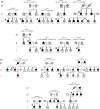Targeted sequencing identifies novel variants in common and rare MODY genes
- PMID: 31595705
- PMCID: PMC6900361
- DOI: 10.1002/mgg3.962
Targeted sequencing identifies novel variants in common and rare MODY genes
Abstract
Background: Maturity-onset diabetes of the young (MODY) is a form of monogenic diabetes with autosomal dominant inheritance. To date, mutations in 11 genes have been frequently associated with this phenotype. In Brazil, few cohorts have been screened for MODY, all using a candidate gene approach, with a high prevalence of undiagnosed cases (MODY-X).
Methods: We conducted a next-generation sequencing target panel (tNGS) study to investigate, for the first time, a Brazilian cohort of MODY patients with a negative prior genetic analysis. One hundred and two patients were selected, of which 26 had an initial clinical suspicion of MODY-GCK and 76 were non-GCK MODY.
Results: After excluding all benign and likely benign variants and variants of uncertain significance, we were able to assign a genetic cause for 12.7% (13/102) of the probands. Three rare MODY subtypes were identified (PDX1/NEUROD1/ABCC8), and eight variants had not been previously described/mapped in genomic databases. Important clinical findings were evidenced in some cases after genetic diagnosis, such as MODY-PDX1/HNF1B.
Conclusion: A multiloci genetic approach allowed the identification of rare MODY subtypes, reducing the large percentage of MODY-X in Brazilian cases and contributing to a better clinical, therapeutic, and prognostic characterization of these rare phenotypes.
Keywords: ACMG/AMP; MODY; MODY-X; targeted sequencing.
© 2019 The Authors. Molecular Genetics & Genomic Medicine published by Wiley Periodicals, Inc.
Conflict of interest statement
Nothing to Disclose—authors LSS, LAC, ADCR, PCF, RPD, AFR, LSW, SPS, MFV, FAP, GCPA, AGFPA, MGRT, WRBG, ACSJ, BH, AALJ, MN, MGT.
Figures


References
-
- Alkorta‐Aranburu, G. , Carmody, D. , Cheng, Y. W. , Nelakuditi, V. , Ma, L. , Dickens, J. T. , … del Gaudio, D. (2014). Phenotypic heterogeneity in monogenic diabetes: The clinical and diagnostic utility of a gene panel‐based next‐generation sequencing approach. Molecular Genetics and Metabolism, 113(4), 315–320. 10.1016/j.ymgme.2014.09.007 - DOI - PMC - PubMed
-
- Bellanne‐Chantelot, C. , Carette, C. , Riveline, J.‐P. , Valero, R. , Gautier, J.‐F. , Larger, E. , … Timsit, J. (2008). The type and the position of HNF1A mutation modulate age at diagnosis of diabetes in patients with maturity‐onset diabetes of the young (MODY)‐3. Diabetes, 57(2), 503–508. 10.2337/db07-0859. - DOI - PubMed
-
- Bellanne‐Chantelot, C. , Clauin, S. , Chauveau, D. , Collin, P. , Daumont, M. , Douillard, C. , … Timsit, J. (2005). Large genomic rearrangements in the hepatocyte nuclear factor‐1 (tcf2) gene are the most frequent cause of maturity‐onset diabetes of the young type 5. Diabetes, 54(11), 3126–3132. 10.2337/diabetes.54.11.3126. - DOI - PubMed
Publication types
MeSH terms
Substances
Supplementary concepts
LinkOut - more resources
Full Text Sources
Medical
Miscellaneous

